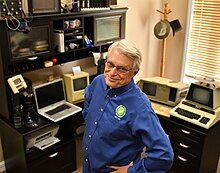Robert C. Martin
This article needs additional citations for verification. (March 2020) |
Robert C. Martin | |
|---|---|
 Martin in 2020 | |
| Born | Robert Cecil Martin 5 December 1952[1] |
| Nationality | American |
| Other names | "Uncle Bob" Martin |
| Occupation | Software engineer, instructor |
| Known for | Agile Manifesto, SOLID principles |
| Children | 4 |
| Website | cleancoder |
Robert Cecil Martin (born 5 December 1952), colloquially called "Uncle Bob",[2] is an American software engineer, instructor, and best-selling author. He is most recognized for developing many software design principles and for being a founder of the influential Agile Manifesto.[3]
Martin has authored many books and magazine articles. He was the editor-in-chief of C++ Report magazine and served as the first chairman of the Agile Alliance.[4][5]
Companies[edit]
In 1991, Martin founded Object Mentor, now defunct, which provided instructor-led training on the extreme programming methodology.[citation needed] As of March 2020[update], he operated two companies:[citation needed]
- Uncle Bob Consulting – provides consulting and training services
- Clean Coders – which provides training videos
Software principles and advocacy[edit]
Five of Martin's principles have become known collectively as the SOLID principles. Though he invented most of the principles he promotes, the Liskov substitution principle was invented by Barbara Liskov,[6] while the open–closed principle was invented by Bertrand Meyer.[7][8]
Martin is a proponent of software craftsmanship, agile software development, and test-driven development.[citation needed]
Publications[edit]
- 1995. Designing Object-Oriented C++ Applications Using the Booch Method. Prentice Hall. ISBN 978-0132038379.
- 2002. Agile Software Development, Principles, Patterns, and Practices. Pearson. ISBN 978-0135974445.
- 2009. Clean Code: A Handbook of Agile Software Craftsmanship. Prentice Hall. ISBN 978-0132350884.
- 2011. The Clean Coder: A Code Of Conduct For Professional Programmers. Prentice Hall. ISBN 978-0137081073.
- 2017. Clean Architecture: A Craftsman's Guide to Software Structure and Design. Prentice Hall. ISBN 978-0134494166.
- 2019. Clean Agile: Back to Basics. Prentice Hall. ISBN 978-0135781869.
- 2021. Clean Craftsmanship: Disciplines, Standards, and Ethics. Addison-Wesley Professional. ISBN 978-0136915805
References[edit]
- ^ Groupon OnAir (July 26, 2016). The Future of Programming with Uncle Bob Martin. YouTube.
- ^ Heusser, Matthew (May 10, 2011). "Do Professional Programmers Need a Code of Conduct? An Interview with Robert C. "Uncle Bob" Martin". InformIT. Retrieved February 26, 2015.
- ^ "Authors: The Agile Manifesto". Manifesto for Agile Software Development. 2001. Retrieved January 16, 2020.
- ^ "Robert C. Martin". IEEE Xplore. Retrieved August 1, 2021.
- ^ Sondra Ashmore; Kristin Runyan (2014). Introduction to Agile Methods. Addison-Wesley Professional. p. 10. ISBN 9780133435214.
- ^ Liskov, Barbara; Wing, Jeannette (November 1, 1994). "A behavioral notion of subtyping". ACM Transactions on Programming Languages and Systems. 16 (6): 1811–1841. doi:10.1145/197320.197383. S2CID 999172.
- ^ Martin, Robert C. (January 1996). "The Open-Closed Principle" (PDF). C++ Report. Archived from the original on August 22, 2006.CS1 maint: unfit URL (link)
- ^ Meyer, Bertrand (1988). Object-oriented software construction. New York: Prentice Hall. p. 23. ISBN 0136290493.